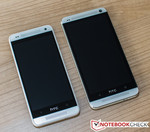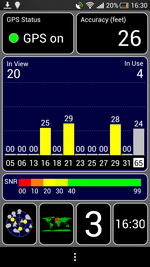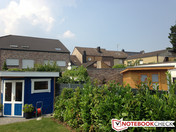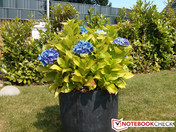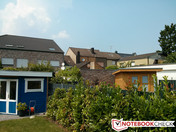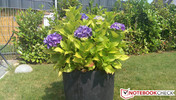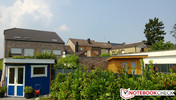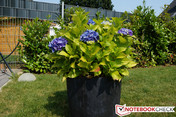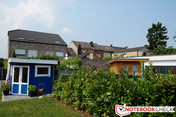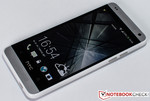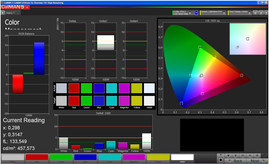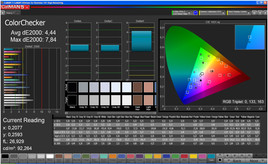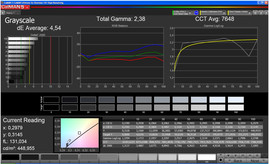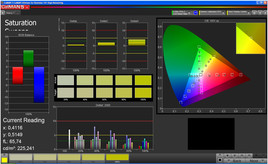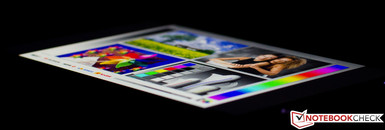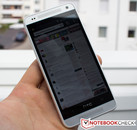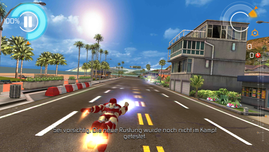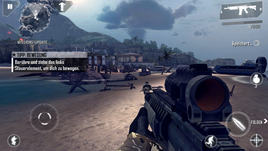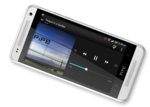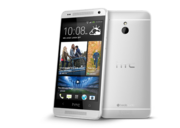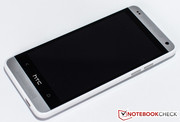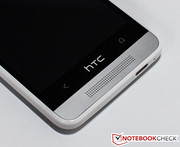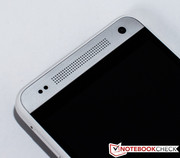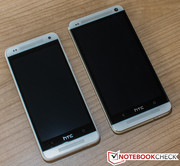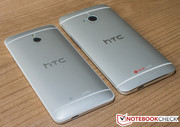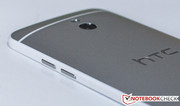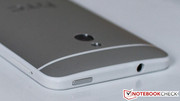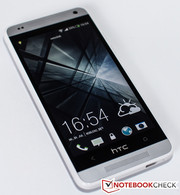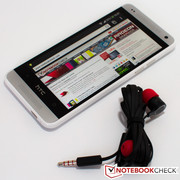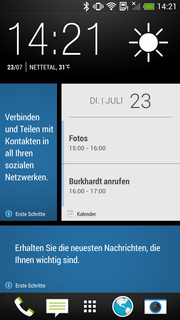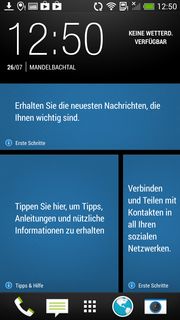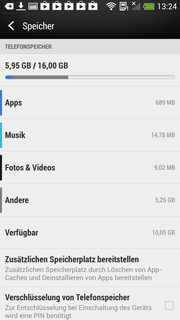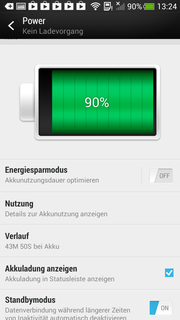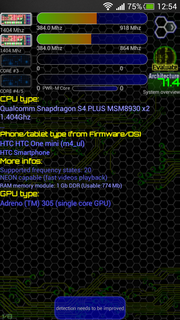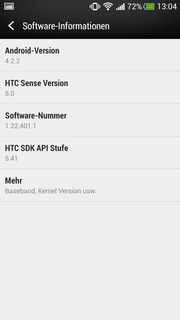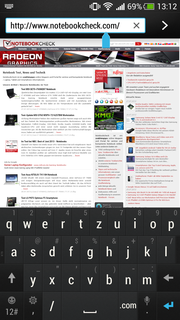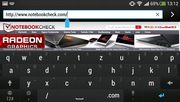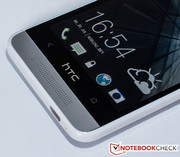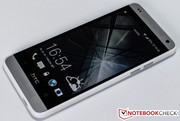Review HTC One Mini Smartphone
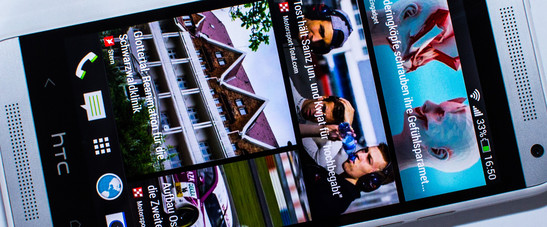
For the original German review, see here.
Not every potential buyer can acquaint themselves with the trend of ever growing smartphones. Samsung led the way by offering a smaller variant of its bestseller Galaxy S3. Naturally the Korean manufacturer has applied the same strategy for the Galaxy S4, but this time the competitors want to have a share of the pie. With the HTC One Mini the Taiwanese manufacturer has introduced a smaller version of its flagship onto the market for the first time. Self-evidently the optical appearance is nearly identical. Big differences can be observed though when having a look at the technical sheet.
The key differentiator is the display that has shrunk to 4.3-inches. Unfortunately HTC also failed to install the Full HD display of the bigger model in the mini variant. Thus the buyer has to be content with an HD resolution of 1280x720 pixels. A Snapdragon 400 by Qualcomm serves as the "engine". This dual-core processor runs at a clock rate of 1.4 GHz and has 1 GB main memory at its disposal. The HTC One Mini and the Samsung Galaxy S4 Mini have to fight the same battle as the two bigger models. The following review will show if one of them emerges as the distinct winner.
Just like its big brother the One Mini conveys a very solid impression: The back is almost exclusively made of aluminum which can also be found above and below the touchscreen at the front. The case border is of less valuable material because the aluminum was replaced by white plastic. Tiny clearances become apparent between the frame and the body in the area of the front camera.
Due to the usage of a lot of metal for the case, the smartphone is very torsion-resistant and equally resistant to pressure. Owing to the rounded back the device is very handy and pleasant to operate. The One Mini loses the direct size comparison to the Galaxy S4 Mini since it is wider, longer and thicker with a measurement of 132 x 63.2 x 9.25 mm. In addition to that the Galaxy S4 Mini is 15 grams lighter (HTC One Mini: 122 grams). Proponents of an aluminum body will surely accept this circumstance.
Our test device is shipped with a memory capacity of 16 GB. We learn from the website of the manufacturer that there won't be any models with different memory configurations. Just like the HTC One the memory of the smaller device cannot be extended with a microSD card. During the first-time setup the buyer is informed that, when signing up or already having a Dropbox account, 25 GB of free memory is held available for 24 months.
The assembly of the ports and keys is nearly identical with that of the bigger variant. The 3.5 mm jack and the power button are situated at the top. An infrared port was not implemented. The two volume buttons are found on the right side of the device. The HTC One still had a one-piece rocker. Microphone and Micro-USB port are at the bottom. The upper left side holds the slot for the Micro-SIM card.
Software
In comparison to the release of the One the One Mini is already shipped with Android 4.2.2. Even though the operating system is the keystone for the software, HTC managed to push the actual operating system slightly into the background with its launcher "Sense 5". The user interface is very well developed and omnipresent. The look of "Sense 5" reaches deep into the system configuration of the software. As already introduced for the HTC One, "HTC BlinkFeed" or "HTC Zoe" must not be missing.
Communication & GPS
Several features had to be left behind along the way from the HTC One to the HTC One Mini. The Near Field Communication module was rationalized as well as the infrared interface - bearable for many buyers. When it comes to the communication modules for mobile internet everything stays as it is. The LTE module still radios at 800/1,800/2,600 MHz and provides a breathtaking download speed of up to 100 Mbit/s. Within one's own four walls the WLAN module connects to the router according to the standard 802.11 a/b/g/n. Bluetooth 4.0 comes with aptX support and the smartphone is able to stream multimedia content to a compatible terminal device via DLNA.
A similarly important feature is the aGPS receiver (incl. GLONASS) which, for example, allows mobile navigation. In our test the mobile phone already connects with the satellites when standing close to a window and enables a precise localization. For the duration of the test we did not detect a relevant loss of connection with any of the radio modules.
Cameras & Multimedia
HTC remains faithful to the UltraPixel camera and uses this module also for our test device. The BSI sensor has a size of 1/3-inch and a maximum aperture of f2.0 with a 28 mm lens. Furthermore the main camera is able to record videos with Full HD quality. The front camera has a 1.6 MP BSI sensor at its disposal and saves videos in HD quality.
We have taken several test pictures to compare the UltraPixel camera. It immediately leaps to the eye that the sensor is of very high luminous intensity. Unfortunately scenes are displayed too faint and lacking in color fidelity. The comparison with camera modules of the competitors is sobering. The difference becomes even more apparent when comparing it to the reference camera (Sony A57). Another disadvantage of the 4 MP sensor is the maximum resolution of the pictures. Even though this results in smaller data the picture promptly becomes blurred when zooming in to have a closer look at a section of the image.
Telephone Functions and Speech Quality
There is nothing to criticize concerning speech quality. Voices are received clearly and distinctly at each end. The playback of the front speaker is very good in speakerphone mode and above all adequately loud. On the road a headset should be used which also leaves a good impression.
Accessories & Warranty
Included in the delivery of our pre-production model are a modular power supply and an in-ear headset in a Beats Audio look. Just like for the HTC One they are not made by Beats Audio though. The tool to open the SIM slot is also enclosed.
The smartphone comes with a warranty period of 24 months. The accessories and the battery are, however, only covered for 12 months.
Input Devices & Handling
The capacitive display responds very precisely to input. The conversion of the input as well as the display rotation by 90 ° work flawlessly and at high speed. Multitouch gestures are also no problem. Just like the HTC One or the Galaxy S4 the One Mini can handle simultaneous input of up to ten fingers. Beforehand the setting "HTC finger movements" in the system preferences needs to be deactivated though.
Writing on the virtual QWERTY keyboard is very pleasant. The height of the keyboard in portrait mode is appropriate. The keyboard takes up less than 50% of the screen. It gets more cramped in landscape mode with slightly more than 50% of the screen.
The key differentiator is the display which has shrunk by 0.4-inches and has a lower resolution. Now there is no Full HD display in use but the smaller variant of an HD display. With a resolution of 1280x720 pixels the pixel density is also lower than that of the HTC One. There is a big difference between the One Mini and the HTC One with 341.5 ppi to 468 ppi. Nonetheless HTC, unlike Samsung, manages to implement an HD display in its mini variant. As a matter of fact, the display of the Galaxy S4 Mini only comes with a gHD resolution and therefore has about 90 ppi less than our test device.
We used our measurement device, the X-Rite i1Pro 2, to further examine the characteristics of the screen. With it we measured an average brightness of 466.1 cd/m², which is significantly brighter compared to the Super-AMOLED display of the Galaxy S4 Mini. However, the two display technologies are not directly comparable. The homogeneity of the illumination lies at 88% and therefore nearly as high as that of the bigger variant. Unfortunately the black value of 0.48 cd/m² is nearly twice as high, which by implication means that the contrast is nearly half as high as that of the HTC One.
| |||||||||||||||||||||||||
Brightness Distribution: 88 %
Center on Battery: 462 cd/m²
Contrast: 963:1 (Black: 0.48 cd/m²)
ΔE ColorChecker Calman: 4.44 | ∀{0.5-29.43 Ø4.78}
ΔE Greyscale Calman: 4.54 | ∀{0.09-98 Ø5}
Gamma: 2.38
CCT: 7648 K
The colorimeter reveals a strong blue deviation of the display, which is already the case for the HTC One. Likewise red tones are displayed too faintly. This results in a cooler color display. The diagram for the color saturation also comes very close to that of the bigger brother. The grayscale values are in the area underneath the 70% mark most widely identical with the ideal values. In very bright areas "white" is displayed too faintly. In everyday usage this is not noticeable though.
Due to the combination of a high contrast with a bright display, the smartphone can score during outdoor usage. Admittedly the contrast is only about 50% of that of the HTC One, but as mentioned at the beginning of the review some sacrifices were to be expected. The device still cuts a fine figure when the automatic brightness control is deactivated.
Just a heads up, when seeking the highest performance and unconditionally high benchmark values you should look for a different smartphone. The smaller variant does not come close to the performance quad-core SoCs of the HTC One or the Galaxy S4. The dual-core Snapdragon 400 by Qualcomm clocks at a rate of 1.4 GHz per core. The chip was produced in the 28 nm procedure and is still based on the ARMv7 platform. In addition to the Adreno 305, a main memory of just 1 GB is deployed. Apart from the higher clock speed of the Galaxy S4 Mini, Samsung also has installed a bigger 1.5 GB main memory. Two factors that will possibly give the S4 Mini a performance advantage.
To optimally compare the performance and also bring the test device to its limits we start with synthetic benchmarks. The brandnew Basemark X 1.0 already shows where this is heading. The One Mini is struggling to keep up with the Galaxy S4 Mini. This is also true for the other performance tests where it fails to draw level with the competitor let alone overtake it. The One Mini, however, manages to beat the older Galaxy S3 in GFXBench 2.7. Sadly this is no breathtaking result for our test device. Apparently the clock rate and the main memory are too little dimensioned to match up to the competitors.
| Basemark X 1.0 | |
| Off-Screen (sort by value) | |
| HTC One Mini | |
| Samsung Galaxy S4 Mini GT-I9195 | |
| On-Screen (sort by value) | |
| HTC One Mini | |
| Samsung Galaxy S4 Mini GT-I9195 | |
| GFXBench (DX / GLBenchmark) 2.7 | |
| T-Rex Onscreen (sort by value) | |
| HTC One Mini | |
| Samsung Galaxy S4 Mini GT-I9195 | |
| Samsung Galaxy S3 | |
| 1920x1080 T-Rex Offscreen (sort by value) | |
| HTC One Mini | |
| Samsung Galaxy S4 Mini GT-I9195 | |
| Samsung Galaxy S3 | |
| AnTuTu v3 - Total Score (sort by value) | |
| HTC One Mini | |
| Samsung Galaxy S4 Mini GT-I9195 | |
| HTC One | |
| Samsung Galaxy S3 | |
| Geekbench 2 - 32 Bit - Total Score (sort by value) | |
| HTC One Mini | |
| Samsung Galaxy S4 Mini GT-I9195 | |
| HTC One | |
| Samsung Galaxy S3 | |
We have included the Nokia Lumia 720 for the evaluation of the browser speed. No clear tendency is detectable in the segment of these performance tests despite the fact that the Windows phone by Nokia permanently performs worse than our test device. Moreover the HTC One Mini wins the tests with Browsermark 2.0 and Peacekeeper but comes off on the short end for Google's Octane as well as Google V8 Ver.7.
| Octane V1 - Total Score (sort by value) | |
| HTC One Mini | |
| Samsung Galaxy S4 Mini GT-I9195 | |
| HTC One | |
| Samsung Galaxy S3 | |
| Nokia Lumia 720 | |
| Browsermark - --- (sort by value) | |
| HTC One Mini | |
| Samsung Galaxy S4 Mini GT-I9195 | |
| HTC One | |
| Samsung Galaxy S3 | |
| Nokia Lumia 720 | |
| Peacekeeper - --- (sort by value) | |
| HTC One Mini | |
| Samsung Galaxy S4 Mini GT-I9195 | |
| HTC One | |
| Samsung Galaxy S3 | |
| Nokia Lumia 720 | |
| Google V8 Ver. 7 - Google V8 Ver. 7 Score (sort by value) | |
| HTC One Mini | |
| Samsung Galaxy S4 Mini GT-I9195 | |
| HTC One | |
| Samsung Galaxy S3 | |
| Nokia Lumia 720 | |
The speed test of the flash memory is relatively distinct though. Only the big brother achieves faster read and write rates. The comparison models are partly significantly slower. The Galaxy S4 Mini achieves a 73% worse result for the random write operation of small data.
| AndroBench 3-5 | |
| Random Write 4KB (sort by value) | |
| HTC One Mini | |
| Samsung Galaxy S4 Mini GT-I9195 | |
| HTC One | |
| Samsung Galaxy S3 | |
| Random Read 4KB (sort by value) | |
| HTC One Mini | |
| Samsung Galaxy S4 Mini GT-I9195 | |
| HTC One | |
| Samsung Galaxy S3 | |
| Sequential Write 256KB (sort by value) | |
| HTC One Mini | |
| Samsung Galaxy S4 Mini GT-I9195 | |
| HTC One | |
| Samsung Galaxy S3 | |
| Sequential Read 256KB (sort by value) | |
| HTC One Mini | |
| Samsung Galaxy S4 Mini GT-I9195 | |
| HTC One | |
| Samsung Galaxy S3 | |
Games
The basic requirement for such a high-priced smartphone is its multimedia capability. Nowadays a smartphone has to be suitable for 3D games and furthermore have no problems with the playback of Full HD movies. This combination is given in the case of the HTC One Mini. The brilliant display and both front speakers guarantee a lot of fun in the field of multimedia applications. We could neither find problems when playing a Full HD trailer nor when playing Iron Man 3 or Modern Combat 4: Zero Hour.
Temperature
The heating of the small metal case under load is not particularly insignificant. At the front we measure an average of 41.1 °C; at the back it is only 1 °C cooler. A more than obvious difference to the big brother. Apparently the waste heat of the SoC can be better dissipated in the bigger case. The measured temperatures of the Galaxy S4 Mini are also lower (front: 38.1 °C, back: 37 °C). All the more gratifying is the temperature during idle which decreases by 10 °C. Therefore the case reaches an average temperature of 29.7 °C, which is a barely noticeable difference to the heating of the HTC One or the Galaxy S4 Mini.
(±) The maximum temperature on the upper side is 43.2 °C / 110 F, compared to the average of 35.2 °C / 95 F, ranging from 21.9 to 247 °C for the class Smartphone.
(±) The bottom heats up to a maximum of 41.4 °C / 107 F, compared to the average of 34 °C / 93 F
(+) In idle usage, the average temperature for the upper side is 29.7 °C / 85 F, compared to the device average of 32.9 °C / 91 F.
Speakers
A purchase argument of the HTC One is among other things the two front speakers. Our test device has similar stereo speakers at its disposal. The quality of the playback is extremely good for a smartphone. The sound is mostly clear. We cannot detect any distortions or overmodulation of the sound, which is true for almost up to the maximum volume. In comparison to the bigger model you naturally have to make a few small sacrifices. Not least because its speakers are a little bit more powerful and bigger.
Power Consumption
The power consumption levels off between 0.6 and 1.3 watts when the test device only handles no or a few tasks. Once again there is a difference noticeable to the Galaxy S4 Mini and the HTC One since both devices need less watts in this scenario. Even though the difference might seem marginal this circumstance can have a big impact on the resulting battery runtime. Under full load we measure a power consumption between 2.9 and 3.8 watts. This time the One Mini behaves similarly to the S4 Mini, whereas our test device is slightly more economical.
| Off / Standby | |
| Idle | |
| Load |
|
Key:
min: | |
Battery Runtime
Just like the bigger variant the battery of the mini version is not interchangeable. The battery of the HTC One has a capacity of 2,300 mAh. The battery of the smaller model was reduced to 1,800 mAh.
We simulate full load within the runtime test with the app Stability Test. It uses all cores to the full, activates the maximum luminance of the display as well as all radio modules. This condition terminates at 2 hours and 39 minutes when the device needs to be recharged. This is an almost identical outcome as that of the runtime test of the Galaxy S4 Mini (2:36 hours). Charging is finished after 2 hours and 12 minutes. A bigger gap can be found in the WLAN test: The One Mini already surrenders to the S4 Mini after 3 hours. When there is no load on the SoC and the display is set to the minimum level of brightness, the battery lasts a reasonable 19 hours and 1 minute. The lights of the S4 Mini, however, stay on for nearly 2 more hours.
Verdict
When having to decide if your next smartphone will be the HTC One Mini or the Samsung Galaxy S4 Mini, you might as well state the question which of the flagships of the manufacturers will be your future companion since both devices fight with the same advantages and disadvantages as the mini variants do. On the one hand the case of both HTC models is made of aluminum and seems more high-grade, on the other hand the battery is not interchangeable and the internal memory cannot be expanded. In contrast to that is the Galaxy S4 Mini with its plastic case and an impression that is not as high-grade. Concerning the display the two models don't differ a lot since both are well equipped for outdoor usage and have extremely high viewing angle stability. Only the resolution varies between the two models - in favor of the One Mini. Performance-wise the S4 Mini has a high clock rate and 50% more main memory at its disposal. The better result becomes apparent in the benchmarks.
As can be seen, it is a constant weighing of the strengths and weaknesses of both devices. Thus a definite recommendation on our site cannot be made because too many personal and therefore subjective impressions and perceptions play a role in this decision. But there is one thing that can be evaluated objectively: the price. With an RRP of 449 Euros (~$599) it is by no means mini. A distinct advantage for the Galaxy S4 Mini since it is currently sold for a price of about 380 Euros (~$507).





